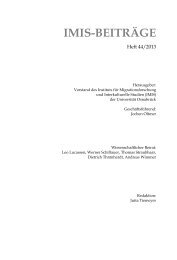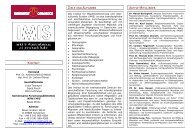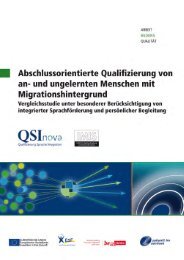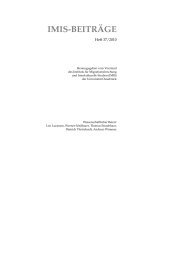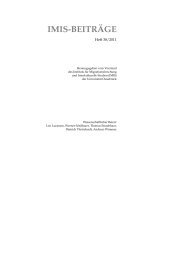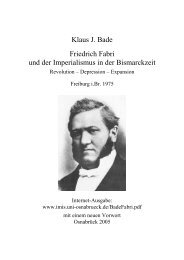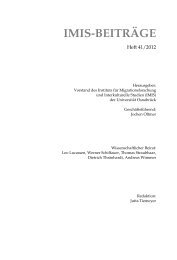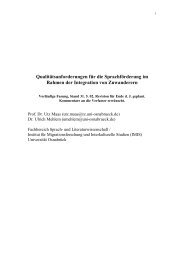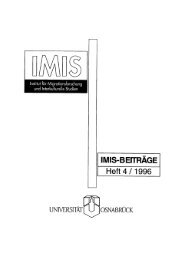Heft 42 - IMIS - Universität Osnabrück
Heft 42 - IMIS - Universität Osnabrück
Heft 42 - IMIS - Universität Osnabrück
Sie wollen auch ein ePaper? Erhöhen Sie die Reichweite Ihrer Titel.
YUMPU macht aus Druck-PDFs automatisch weboptimierte ePaper, die Google liebt.
Sedentarismus als Konstante der Migrationsforschung in Afrika<br />
Letztlich sind diese bis heute gängigen Interpretationen von Migrationen im<br />
historisch-strukturalistischen Paradigma der 1970er und 1980er Jahre verhaftet.<br />
Dabei wurde Migration nicht theoretisiert, sondern Wanderungen als<br />
Problemlösungsstrategie gegenüber der dem kapitalistischen Akkumulationsprozess<br />
intrinsischen Störungen und Dislokationen verstanden. 59<br />
Für die Bewertung von Mobilität in Afrika hatte dies die dominante<br />
Vorstellung von Migration als Bewältigungsstrategie gegenüber sozialer und<br />
ökonomischer Ungleichheit, Armut und Hunger im Push-Pull-Paradigma<br />
zur Folge. Migration erscheint hier als eine Reaktion auf eine nicht mehr<br />
(er)tragbare Situation, als Strategie in einer Notlage und damit als Option,<br />
auf die nur in Ausnahmefällen zurückgegriffen wird.<br />
»For poor Africans, compelled to leave their areas of origin when conditions fell<br />
below a critical threshold of tolerance, migration in any form is a response to<br />
essentially the same underlying factors – the pull of opportunity and the push of<br />
abject poverty«. 60<br />
Armut als die zentrale Antriebskraft für Wanderungen gehört zu den »myths<br />
of migration«. 61 Dieser Mythos hält sich ungeachtet der Erkenntnis, dass höhere<br />
Einkommen mit einer Erhöhung der Migrationsraten verknüpft sind,<br />
hartnäckig auch in politischen Strategiepapieren:<br />
»Turning to the migration and development agenda, the prime challenge is to<br />
tackle the main push factors for migration: poverty and the lack of job opportunities.<br />
The EU must recognise that creating jobs in developing countries could significantly<br />
reduce migratory pressure from Africa. The EU Programme on Development<br />
and Migration in Africa would seek to provide a short-term developmental<br />
response to migration challenge for ACP countries. The first objective of this joint<br />
programming initiative would be to address in a serious manner the lack of decent<br />
jobs in Africa. Promoting investments in labour-intensive sectors in regions with<br />
high outward migration will be an important priority«. 62<br />
Bakewell/Hein de Haas, African Migrations: Continuities, Discontinuities and Recent<br />
Transformations, in: Patrick Chabal/Ulf Engel/Leo de Haan (Hg.), African Alternatives,<br />
Leiden 2007, S. 95–118; Fleur Wouterse/J.E. Taylor, Migration and Income<br />
Diversification: Evidence from Burkina Faso, in: World Development, 36. 2008,<br />
S. 625–640.<br />
59 Massey u.a., Theories of International Migration, S. 36.<br />
60 Aderanti Adepoju, Internal and International Migration within Africa, in: Pieter Kok<br />
u.a. (Hg.), Migration in South and Southern Africa. Dynamics and Determinants,<br />
Kapstadt 2006, S. 26–45, hier S. 36.<br />
61 Ronald Skeldon, Migration and Development: A Global Perspective, Harlow 1997,<br />
S. 7; vgl. auch Hein de Haas, Turning the Tide? Why Development will Not Stop<br />
Migration, in: Development and Change 38. 2007, H. 5, S. 819–841.<br />
62 Commission of the European Communities (CEC),The Global Approach to Migration<br />
One Year on: Towards a Comprehensive European Migration Policy, Brüssel 2006, S. 5.<br />
73



